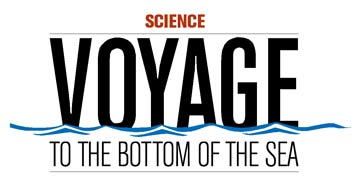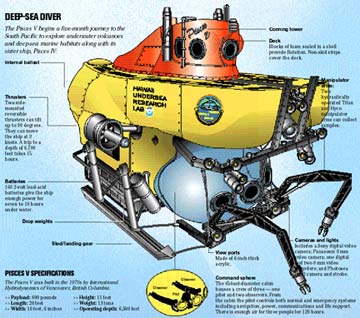
The South Pacific expedition
is HURL's most ambitious
Scientists diving in Hawaii Undersea Research Laboratory submersibles have developed a fascinating picture of the undersea world around the Hawaiian Islands.
They've monitored Loihi, a future island growing on Hawaii's hotspot off the Big Island with towering peaks and a 4,600-foot deep pit -- dubbed Pele's Pit.
They've seen bizarre deep-ocean critters and collected tiny organisms from high-temperature hydrothermal vents with potential for new medicines and other products.
They've surveyed fisheries and coral reefs up to the Northwestern Hawaiian Islands and learned a lot about the surrounding seas to aid policy decisions about marine resources.

Giants of the deep: The Pisces V will explore up to 12 volcanic cones, some rising as high as 20,000 feet above the ocean floor.
CLICK FOR LARGER VERSION
They found still more marine relics during test dives Thursday off Oahu -- a unique World War II Japanese I-401 submersible aircraft carrier and a World War I S-19 submarine scuttled in the 1930s.
Now, the three-person submersibles Pisces IV and Pisces V and mother ship Ka'imikai-O-Kanaloa (Heavenly Searcher of the Sea) have embarked on a bold $4.4 million five-month South Pacific expedition.
The ship left Friday for a pioneering look at some gigantic undersea volcanoes and studies of waters between Hawaii and New Zealand. Scientists from the United States, Germany, New Zealand and Australia are participating in the longest and most difficult research mission in HURL's 25-year history.
The University of Hawaii and the National Oceanic and Atmospheric Administration operate the submersible program. It began in 1980 under then state Marine Affairs Coordinator John Craven as part of NOAA's man-in-the-sea program, acting HURL director John Wiltshire recalled.
The name was changed to Hawaii Undersea Research Laboratory in 1981 and operations began with the Makali'i, a two-person submersible initially called Star II. It was given to UH as a tax write-off by General Dynamics in the early 1970s and leased to Maui Divers for coral harvesting until 1981, Wiltshire said.
The Makali'i could only go down 1,300 feet (Pisces IV and V can dive 6,600 feet) but it did a lot of ocean science with the late Bo Bartko and Terry Kerby as chief submersible pilots.
Kerby had piloted Star II and joined the undersea laboratory in 1981 as operations director, leading the first science dives with Makali'i at Enewetak Atoll in the Marshall Islands.
Alex Malahoff became HURL director in 1984 and began looking for a deep-diving submersible. He found Pisces V in a Scotland warehouse and brought it here in 1985.
Then in 1987, with the oil industry in a slump, HURL bought a $20 million ship for $800,000 at a bankruptcy auction, Wiltshire said.
The Ka'imikai-O-Kanaloa's first cruise was to Johnston Atoll in 1993 after six years in a shipyard for reconfiguration and addition of a 40-foot section. A SeaBeam multibeam sonar system that maps the sea floor and a remotely operated vehicle were added later.
In 1999, Malahoff learned Canada was selling Pisces IV and scrambled to get it for about $100,000. He said he felt more comfortable going to extreme parts of the Pacific with two submersible systems.
With changes made by Kerby and his crew, pilot Max Cremer and pilots-in-training Steve Price and Colin Wolleman, the 20-foot submersibles are nearly identical, so parts can be exchanged in emergencies.
The Japanese have better diving equipment but HURL has Kerby, "one of the greatest submarine operators in the world," Wiltshire said. "Dive work with Terry will be incredibly productive. ... He can almost sniff out where good stuff is and get in there, get it and get out."
Kerby also keeps detailed records and sketches images from the submersible, which he recreates with paintings.
Malahoff took leave from UH in 2002 to be chief executive of the Institute of Geological and Nuclear Sciences Ltd. in New Zealand and organize partners and financing for the South Pacific Expedition.
It's now underway with the first dives scheduled March 30 on Samoa's undersea volcano Vailulu'u.
www.soest.hawaii.edu/HURL
[News] [Business] [Features] [Sports] [Editorial] [Do It Electric!]
[Classified Ads] [Search] [Subscribe] [Info] [Letter to Editor]
[Feedback]
